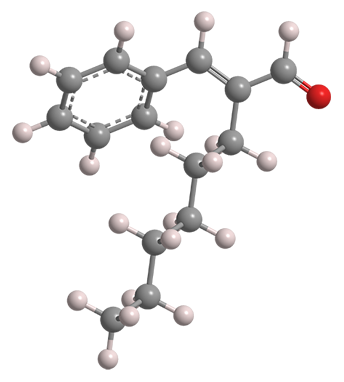What molecule am I?


2-Hexylcinnamaldehyde, colloquially “hexyl cinnamal” and formally 2-(phenylmethylene)octanal, is a fragrance ingredient used in perfumes and personal-care products. By itself, it has a jasmine-like odor.
2-Hexylcinnamaldehyde occurs naturally in chamomile oil, but almost all of the commercial product is synthesized via a reaction between octanal and benzaldehyde. An antioxidant such as 2,6-di-tert-butyl-4-methoxyphenol (“butylated hydroxyanisole”) is usually added as a preservative.
In 2017, the Unilever conglomerate based in London, UK, and Rotterdam, The Netherlands, announced that it would disclose the fragrance ingredients—including 2-hexylcinnamaldehyde—in ≈1100 of its products. The project was completed this past January. Consumers can view the ingredients in Unilever products at its smartlabel.org Web site.
2-Hexylcinnamaldehyde hazard information
| GHS classification*: skin sensitization, category 1 | |
| H317—May cause an allergic skin reaction | |
| GHS classification: hazardous to the aquatic environment, acute hazard, category 3 | |
| H402—Harmful to aquatic life | |
| GHS classification: hazardous to the aquatic environment, long-term hazard, category 3 | |
| H412—Harmful to aquatic life with long-lasting effects | |
*Globally Harmonized System of Classification and Labeling of Chemicals. Explanation of pictograms.
MOTW updates
Ketamine was the Molecule of the Week for May 25, 2015. It is a versatile 1960s-era drug that over the years has been used as an anesthetic and antidepressant. As effective as it is, scientists have been unable to determine its mode of action. But this month, Conor Liston and colleagues at Weill Cornell Medicine (New York City) reported that when they injected ketamine into “depressed” mice, the animals began to regrow dendritic spines on their nerve cells and came out of their lethargy.
Cyclodextrins were the Molecules of the Week for September 21, 2015. They consist of sugar molecules (glucopyranosides) arranged in rings. The 6-, 8-, and 10-membered cyclodextrins occur naturally; and until recently the smallest ring to be synthesized contained five glucopyranoside units. This record was broken earlier this month when Hidetoshi Yamada and co-workers at Kwansei Gakuin University (Nishinomiya, Japan) announced that they made cyclodextrins with three and four sugar units—the smallest possible members of the family.
Happy Chemists Celebrate Earth Week (CCEW)!
From April 21 through April 27, ACS members and chemistry enthusiasts across the globe are raising public awareness of green chemistry through the annual CCEW campaign. The theme of CCEW 2019 is “Take Note: The Chemistry of Paper”. Celebrate on social media by sharing the molecules vital to paper chemistry, cellulose and lignin, and by using the hashtag #CCEW!
2-Hexylcinnamaldehyde fast facts
| CAS Reg. No. | 101-86-0 |
| Empirical formula | C15H20O |
| Molar mass | 216.32 g/mol |
| Appearance | Pale yellow liquid or solid |
| Melting point | 39 ºC |
| Boiling point | 308 ºC |
| Water solubility | 3–5 mg/L |

Learn more about this molecule from CAS, the most authoritative and comprehensive source for chemical information.
Molecule of the Week needs your suggestions!
If your favorite molecule is not in our archive, please send us a message. The molecule can be notable for its current or historical importance or for any quirky reason. Thank you!
Stay Ahead of the Chemistry Curve
Learn how ACS can help you stay ahead in the world of chemistry.


